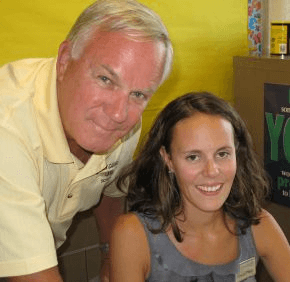By Maureen Cromer
mcromer@CatholicReview.org
BEL AIR – The 86-year-old related what she described as three miracles, ones that allowed her to join 18 other survivors for a Holocaust Remembrance Day program at the only Catholic high school in Harford County.
The program is held annually at John Carroll, shedding light on a horror in which an estimated 6 million Jews were killed in a genocide perpetrated by Nazi Germany at the direction of Adolf Hitler.
In 1939, a 10-year-old Halina Silber and her Jewish family were forced from their home in Kraków into a ghetto in Słomniki, another town in Poland. After living in Słomniki for some time, rumors began circulating that Nazi soldiers were going to be “relocating” the Jewish population.
Silber’s mother instructed her to remove her Nazi-issue armband which displayed the Star of David, hitchhike back to Kraków and lie about her age in order to be eligible to volunteer at the labor camp where her brother and sister were already working.
As Silber waved goodbye to her mother, she did not realize it would be the last time they would see each other. That escape from Słomniki, Silber said, was her first miracle.
After a brief imprisonment for lack of identification papers, she was accepted into the labor camp and worked in the laundry facilities. She was then transferred to an enamelware factory in Kraków, where she carried pots and pans to the burner. Silber began to believe that she would die due to the working conditions and her own frailty.
The second miracle came when the factory owner recognized how taxing the job was to her health, and asked Silber if she would rather clean the offices.
That factory owner was Oskar Schindler, a German who was a member of the Nazi party, but also a Catholic. In late 1944, when the factory was closed, he schemed to send his Jewish workers to his ammunition factory in Czechoslovakia. His heroism inspired “Schindler’s List,” which won the Oscar as Best Motion Picture in 1994.
Silber began to recount the day the workers loaded the train that would be taking them from the Kraków factory to Czechoslovakia. When the train doors opened, however, the workers found themselves facing the doors of Auschwitz, the infamous Nazi death camp outside Kraków.
She and the others on the train were told they were being taken to the showers, and instructed to strip themselves of their clothing.
“I could smell burning flesh coming from all directions,” Silber recalled.
Unsure of whether or not they were being sent into actual showers or a gas chamber, the workers entered a large room. When water began to spray from above them, Silber was overcome with relief.
Workers from Schindler’s factory stayed in Auschwitz for several weeks before a German SS soldier called their names from the list. They boarded another train – headed for Czechoslovakia. That, Silber said, was the third miracle.
The Jewish workers on Schindler’s list worked in his ammunition factory until May 8, 1945 when Russian soldiers informed them that World War II was over and they were finally free.
Schindler jeopardized his career, political standing and his own safety to save over 1,200 Jews, and is remembered as a hero.
Silber’s story made for a moving program at John Carroll. Louise Geczy had started a similar program at Perry Hall High School, and brought the concept to John Carroll when she joined the staff there in the early 2000s.
“Nothing I have ever taught resonates more with the students than the stories and testimonies from Holocaust survivors,” said Geczy, the school’s senior project coordinator. “It’s truly a life-changing experience to sit across from a survivor and hear their story.”
Students heard from both survivors and a liberator. Sol Goldstein, who was part of the D-Day invasion of Normandy, recounted his story of survival and victory.
Herbert Hane, who was raised Catholic in Berlin, related the survival story of his father, a Jew.
Jeanette Parmigiani, Director of Holocaust Programs at the Baltimore Jewish Council, said, “Once the survivors come here, they want to come back again.”
Asked by a student if young generations are doing enough to remember the Holocaust, Silber replied, “Most Holocaust survivors have already passed away. So when the rest of us have gone, you must be the ones to keep reminding the world of our past.”
Holocaust survivor film comes to John Carroll
‘Hate eats you inside’: 95-year-old Holocaust survivor speaks at John Carroll


